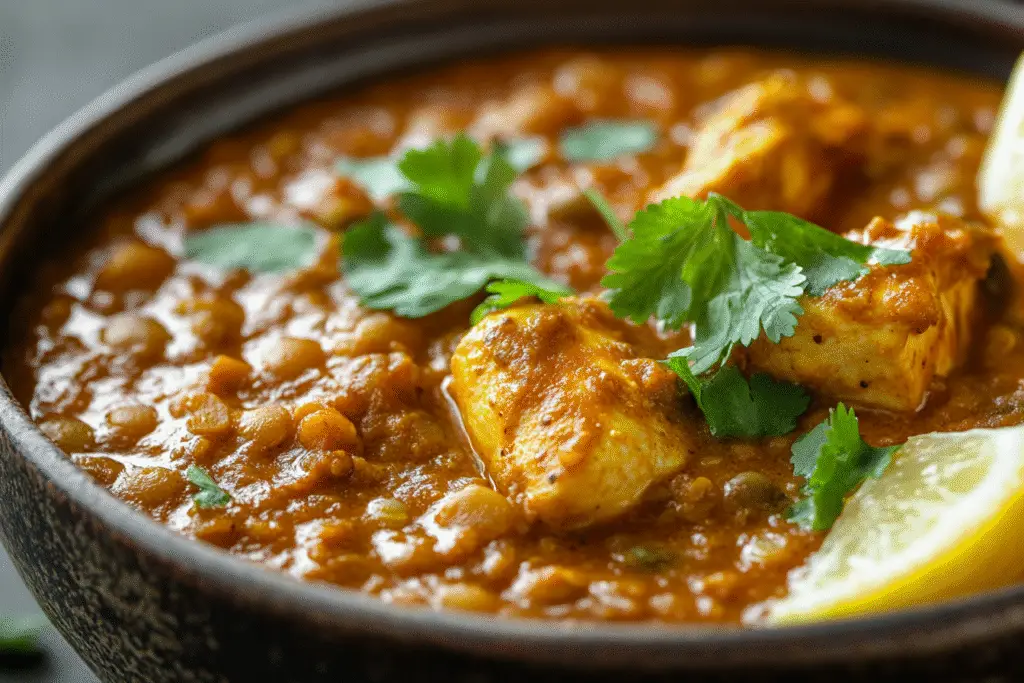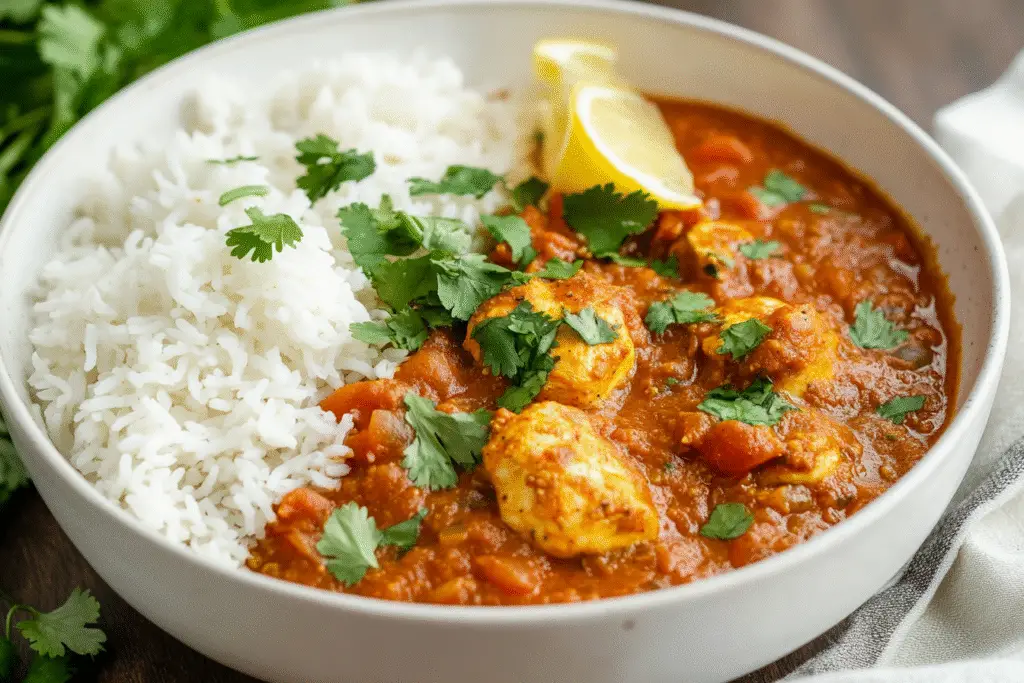What Makes Chicken Dhansak So Special?
Chicken Dhansak is a cherished dish from Parsi cuisine that harmoniously blends the bold spices of Indian cooking with sweet, tangy, and slightly smoky undertones. Traditionally, dhansak combines lentils, vegetables, and meat (often chicken or lamb) in a richly spiced sauce that’s deeply satisfying and complex. What sets dhansak apart from other curries is its delicate balance of sweet, sour, spicy, and savory flavors — often finished with a squeeze of fresh lemon to brighten the dish.
Unlike many popular curries that are either solely creamy or strictly spicy, Chicken Dhansak offers layers of nuanced flavor, making it a comforting yet vibrant meal. This dish is typically served with caramelized brown rice, which complements the slight sweetness of the curry. While it’s often associated with Sunday family meals in Parsi households, Chicken Dhansak has won hearts around the world as a warming, hearty dish that’s ideal for cozy nights in.
Ingredient Selection: The Backbone of Flavor
The authenticity of Chicken Dhansak hinges on a thoughtful selection of ingredients:
- Chicken: Boneless, skinless chicken thighs are preferred for their tenderness and flavor. Chicken breast can be used, but it’s more prone to drying out in the simmering process.
- Lentils: A combination of red lentils (masoor dal) and yellow split lentils (toor dal or chana dal) provides body and a creamy texture to the sauce.
- Vegetables: Traditionally, a mix of eggplant, pumpkin, and sometimes squash or spinach is used. These soften into the sauce, adding subtle layers of flavor and nutrition.
- Spices: The signature spice mix usually includes cumin, coriander, turmeric, cinnamon, and garam masala, alongside fresh ginger and garlic for depth.
- Sweeteners: Brown sugar or jaggery balances the spices with a mild sweetness.
- Acid: Lemon juice or tamarind paste provides the necessary tang to cut through the richness.
Opting for high-quality, fresh spices will make a noticeable difference in flavor intensity.

Recommended Equipment for a Smooth Cooking Process
You don’t need fancy gadgets to make Chicken Dhansak, but a few well-chosen tools can streamline the process:
- Large, heavy-bottomed pot or Dutch oven: Essential for even cooking and preventing the lentils from sticking.
- Blender or immersion blender: To achieve a smooth, velvety sauce.
- Fine mesh strainer (optional): For rinsing lentils thoroughly to remove excess starch.
- Sharp chef’s knife: For dicing vegetables uniformly.
- Wooden spoon: Useful for stirring the sauce without scratching the pan.
Common Challenges and How to Overcome Them
1. Lentils Not Cooking Properly
Lentils can remain firm if they’re not simmered long enough or if acidic ingredients (like lemon or tomatoes) are added too early. Always cook lentils until tender before introducing acidic elements.
2. Chicken Drying Out
Using chicken breast can lead to dryness if overcooked. Chicken thighs offer more forgiveness. Simmer gently to keep the meat tender.
3. Sauce Too Thick or Thin
The sauce can become overly thick as lentils break down. Adjust by adding hot water or chicken stock to reach your desired consistency. If the sauce is too thin, simmer uncovered to reduce.
Ingredient Swaps and Dietary Adjustments
- Meat Alternatives: Replace chicken with lamb for a richer dish, or tofu/seitan for a plant-based version.
- Vegetarian/Vegan: Omit the chicken and add more vegetables like zucchini, mushrooms, and sweet potatoes.
- Sweeteners: Brown sugar can be swapped with honey, maple syrup, or coconut sugar for dietary preferences.
- Tamarind Substitute: Use lemon juice or a splash of vinegar for acidity if tamarind paste is unavailable.
- Gluten-Free: Naturally gluten-free, just ensure your stock and spice blends don’t contain hidden gluten.
Preparation Strategies to Save Time
- Pre-soak lentils for 30 minutes to speed up cooking.
- Dice vegetables and measure spices in advance for smooth workflow.
- Cook the lentils and chicken separately the day before, then combine when ready to serve.
- Use store-bought garam masala to reduce the number of individual spices needed.
Flavor Enhancements and Side Pairings
- Add smoked paprika or black cardamom for a subtle smoky edge, traditionally achieved by smoking the curry with hot coal (which can be tricky at home).
- Include a spoonful of mango chutney stirred into the sauce for extra sweetness.
- Pair with caramelized brown rice for a more authentic Parsi presentation.
- Serve with naan, roti, or steamed basmati rice to soak up the richly flavored sauce.
For an extra punch, sprinkle with fresh coriander leaves and a final squeeze of lemon right before serving.

Chicken Dhansak Recipe
Ingredients
For the Chicken and Lentils
- 1.5 lbs (700g) boneless, skinless chicken thighs, cut into bite-sized pieces
- 3/4 cup red lentils (masoor dal)
- 1/4 cup yellow split lentils (toor dal or chana dal)
- 1 medium eggplant, peeled and diced
- 1 cup pumpkin or butternut squash, diced
- 1 large onion, finely chopped
- 3 cloves garlic, minced
- 1 tablespoon fresh ginger, grated
- 2 medium tomatoes, chopped
- 4 cups chicken stock or water
- 2 tablespoons oil (vegetable or ghee)
- Salt, to taste
Spice Mix
- 1 teaspoon cumin seeds
- 1 teaspoon coriander powder
- 1 teaspoon turmeric powder
- 1 teaspoon paprika
- 1/2 teaspoon cinnamon
- 1 teaspoon garam masala
- 1/4 teaspoon chili powder (optional for heat)
Sweet and Sour Elements
- 1 tablespoon brown sugar or jaggery
- 1 tablespoon tamarind paste or juice of 1 lemon
Garnish
- Fresh cilantro leaves
- Lemon wedges
- Sliced red onions (optional)
Instructions
Step 1: Prepare the Lentils
- Rinse the red and yellow lentils under cold water until the water runs clear. Drain well.
- In a large pot, combine the lentils with 3 cups of chicken stock or water. Bring to a boil, then reduce heat to low and simmer, partially covered, for 20–25 minutes until the lentils are soft.
Step 2: Sauté Aromatics and Chicken
- In a separate large pot or Dutch oven, heat oil over medium heat.
- Add cumin seeds and let them sizzle for 30 seconds until aromatic.
- Add the chopped onion, garlic, and ginger. Sauté for 5–7 minutes until the onions are soft and golden.
- Stir in coriander powder, turmeric, paprika, cinnamon, garam masala, and chili powder (if using). Cook for 1 minute to toast the spices.
Step 3: Build the Curry Base
- Add the chicken pieces and sauté for 4–5 minutes until lightly browned.
- Stir in the chopped tomatoes, eggplant, and pumpkin. Cook for 5 minutes to soften slightly.
Step 4: Combine and Simmer
- Pour in the cooked lentils along with their cooking liquid. Add the remaining 1 cup of chicken stock.
- Bring the curry to a simmer, cover, and cook for 20–25 minutes, stirring occasionally, until the vegetables are soft and the chicken is cooked through.
Step 5: Sweet and Sour Balance
- Stir in brown sugar and tamarind paste (or lemon juice). Simmer uncovered for another 5 minutes to thicken the sauce and meld the flavors.
- Season with salt to taste.
Step 6: Adjust Texture
- For a smoother sauce, use an immersion blender to partially blend the curry in the pot. Alternatively, blend a portion and stir it back in, leaving some chunks for texture.
Step 7: Garnish and Serve
- Ladle the Chicken Dhansak into bowls.
- Garnish with fresh cilantro, a squeeze of lemon juice, and optional sliced red onions.
- Serve with basmati rice, caramelized brown rice, or naan.
Storage and Reheating
- Storage: Store leftovers in an airtight container in the refrigerator for up to 3 days.
- Reheating: Gently reheat on the stovetop over low heat or in the microwave at medium power, stirring occasionally.
Troubleshooting Tips
- If the curry is too thick, add warm water or stock to loosen.
- If it tastes too sweet, balance with a little extra lemon juice or tamarind.
- If it lacks depth, add a pinch more garam masala and simmer briefly.
Variations: Dhansak vs. Other Curries
- Dhansak vs. Tikka Masala: Dhansak is lentil-based with sweet and sour notes, while tikka masala is creamy and tomato-heavy.
- Dhansak vs. Madras: Madras curry is typically hotter and more oil-based, while Dhansak balances heat with sweetness and lentil creaminess.
- Vegetarian Dhansak: Common in Parsi cuisine, replacing chicken with paneer or hearty vegetables like potatoes, sweet potatoes, or zucchini.
Serving Suggestions
- Caramelized Brown Rice: Traditional accompaniment, often cooked with caramelized onions for sweetness.
- Fresh Salads: Thinly sliced red onions, cucumbers, and tomatoes with lemon juice add crunch and freshness.
- Chutneys: Mango or mint chutney pairs beautifully with the sweet and sour curry profile.
- Flatbreads: Naan or roti to scoop up the thick, flavorful sauce.
Chicken Dhansak offers an exquisite balance of flavors that’s both comforting and exciting — perfect for a special weekend meal or an inviting addition to your regular dinner rotation.
